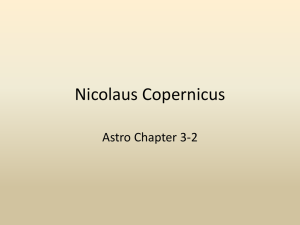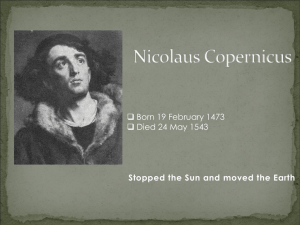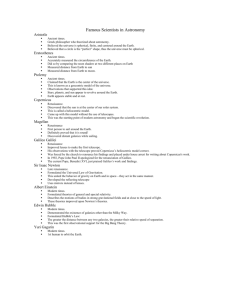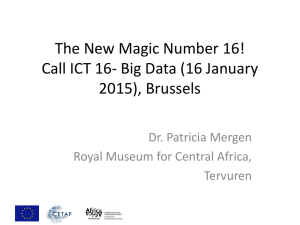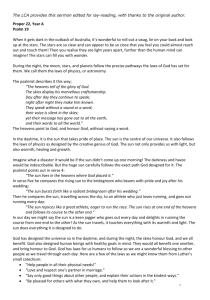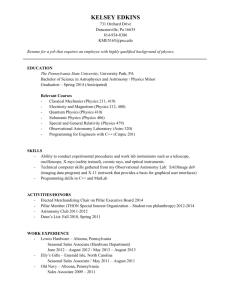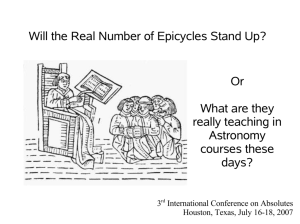Practice Quotation: Edict of Nantes (1598) [assigned reading: pp
advertisement
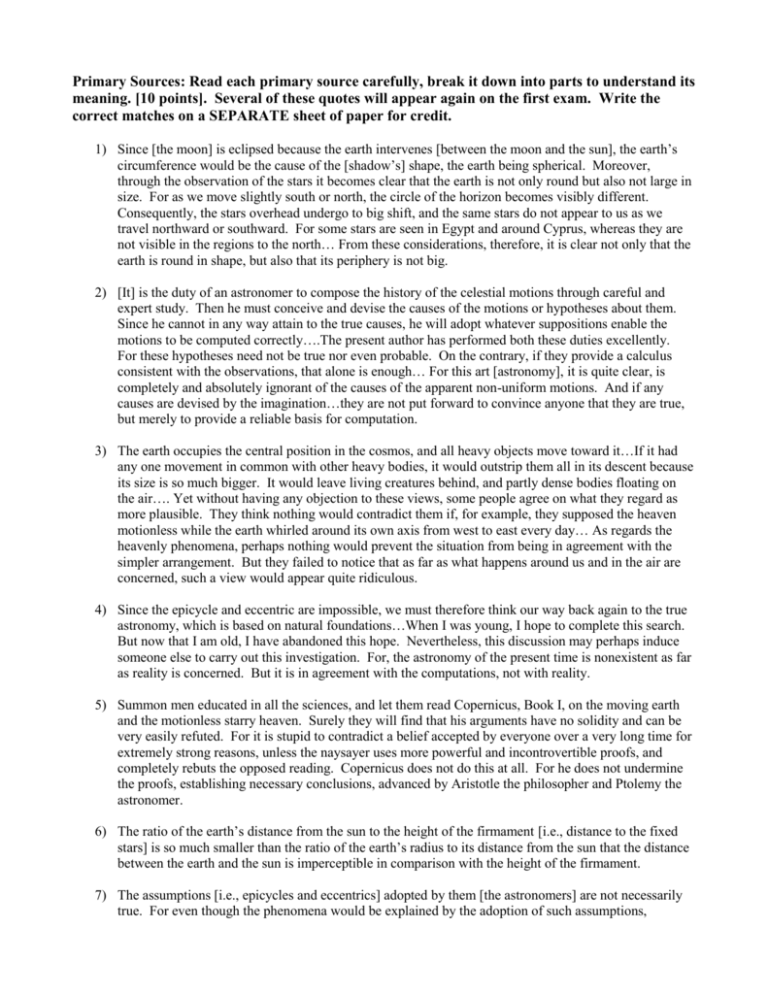
Primary Sources: Read each primary source carefully, break it down into parts to understand its meaning. [10 points]. Several of these quotes will appear again on the first exam. Write the correct matches on a SEPARATE sheet of paper for credit. 1) Since [the moon] is eclipsed because the earth intervenes [between the moon and the sun], the earth’s circumference would be the cause of the [shadow’s] shape, the earth being spherical. Moreover, through the observation of the stars it becomes clear that the earth is not only round but also not large in size. For as we move slightly south or north, the circle of the horizon becomes visibly different. Consequently, the stars overhead undergo to big shift, and the same stars do not appear to us as we travel northward or southward. For some stars are seen in Egypt and around Cyprus, whereas they are not visible in the regions to the north… From these considerations, therefore, it is clear not only that the earth is round in shape, but also that its periphery is not big. 2) [It] is the duty of an astronomer to compose the history of the celestial motions through careful and expert study. Then he must conceive and devise the causes of the motions or hypotheses about them. Since he cannot in any way attain to the true causes, he will adopt whatever suppositions enable the motions to be computed correctly….The present author has performed both these duties excellently. For these hypotheses need not be true nor even probable. On the contrary, if they provide a calculus consistent with the observations, that alone is enough… For this art [astronomy], it is quite clear, is completely and absolutely ignorant of the causes of the apparent non-uniform motions. And if any causes are devised by the imagination…they are not put forward to convince anyone that they are true, but merely to provide a reliable basis for computation. 3) The earth occupies the central position in the cosmos, and all heavy objects move toward it…If it had any one movement in common with other heavy bodies, it would outstrip them all in its descent because its size is so much bigger. It would leave living creatures behind, and partly dense bodies floating on the air…. Yet without having any objection to these views, some people agree on what they regard as more plausible. They think nothing would contradict them if, for example, they supposed the heaven motionless while the earth whirled around its own axis from west to east every day… As regards the heavenly phenomena, perhaps nothing would prevent the situation from being in agreement with the simpler arrangement. But they failed to notice that as far as what happens around us and in the air are concerned, such a view would appear quite ridiculous. 4) Since the epicycle and eccentric are impossible, we must therefore think our way back again to the true astronomy, which is based on natural foundations…When I was young, I hope to complete this search. But now that I am old, I have abandoned this hope. Nevertheless, this discussion may perhaps induce someone else to carry out this investigation. For, the astronomy of the present time is nonexistent as far as reality is concerned. But it is in agreement with the computations, not with reality. 5) Summon men educated in all the sciences, and let them read Copernicus, Book I, on the moving earth and the motionless starry heaven. Surely they will find that his arguments have no solidity and can be very easily refuted. For it is stupid to contradict a belief accepted by everyone over a very long time for extremely strong reasons, unless the naysayer uses more powerful and incontrovertible proofs, and completely rebuts the opposed reading. Copernicus does not do this at all. For he does not undermine the proofs, establishing necessary conclusions, advanced by Aristotle the philosopher and Ptolemy the astronomer. 6) The ratio of the earth’s distance from the sun to the height of the firmament [i.e., distance to the fixed stars] is so much smaller than the ratio of the earth’s radius to its distance from the sun that the distance between the earth and the sun is imperceptible in comparison with the height of the firmament. 7) The assumptions [i.e., epicycles and eccentrics] adopted by them [the astronomers] are not necessarily true. For even though the phenomena would be explained by the adoption of such assumptions, nevertheless it must not be said that these assumptions are true. For, the heavenly phenomena may perhaps be explained in some other way not yet understood by mankind. 8) It seems not only completely contrary to the rules of logic but altogether impious to mingle fictions with the sacred doctrine of the heavens, especially false and absurd fictions. But the hypotheses of epicycles and eccentrics are false and absurd fictions… With regard to the epicycles and eccentrics, the astronomers are seriously mistaken… I beseech you, undertake the task most deserving of your outstanding skill to permit astronomy, freed by you from fictional hypotheses, to display to men’s minds the lights of its stars just as nature presented them to be contemplated by our eyes. 9) Whatever is done by an epicycle, however, can be accomplished in the same way by an eccentric… There is no difference between them, provided that the distance between their centers is equal to the epicycle’s radius. Hence it is not easy to decide which of them exists in the heavens. 10) Why should we not admit, with regard to the daily rotation [of the earth], that the appearance is in the heavens and the reality in the earth? This situation closely resembles what Virgil’s Aeneas says: Forth from the harbor we sail, and the land and the cities slip backward (Aeneid, III, 72). For when a ship is floating calmly along, the sailors see its motion mirrored in everything outside, while on the other hand they suppose that they are stationary, together with everything on board. In the same way, the motion of the earth can unquestionably produce the impression that the entire universe is rotating. Match the correct primary source quotations above with the descriptions and writers below. A) Although admitting it’s difficult to decide, the author argues in favor of epicycles and eccentrics as really existing in the heavens. [Nicolaus Copernicus (1473-1543), De revolutionibus (1543)] B) The writer rejects the reality of epicycles and eccentrics, saying that there is not yet a true astronomy only one for computing purposes. [Ibn Rushd (Averroes) (1126-1198), Commentary on Aristotle’s Metaphysics] C) The quote remarks that epicycles and eccentrics might be true, but are not necessarily true because motions in the heavens could be explained in other ways. [Thomas Aquinas (c. 1225-1274), Commentary on Aristotle’s Heavens] D) Excerpt argues for the relativity of motion. If passengers aboard a moving ship perceive that everything else is moving, it is possible that the earth’s motion makes it appear that the universe is in motion. The writer quotes an ancient Roman poet, so he’s probably a Renaissance humanist. [Nicolaus Copernicus, De revolutionibus (1543)] E) The passage complains that epicycles and eccentrics are fictions that destroy true astronomy. He asks the reader to liberate astronomy from these absurd hypotheses. [Peter Ramus (1515-1572), letter to Rheticus, a Lutheran mathematician-astronomer who encouraged Copernicus to publish (25 August, 1563)] F) The source offers several observations, including the shadow cast by the earth on the moon during a lunar eclipse, illustrating that the earth is spherical and not that large in size. [Aristotle (384-322 B.C.), On the Heavens] G) The excerpt rejects the arguments of Copernicus, saying that there are very strong reasons for retaining Aristotle’s philosophy and Ptolemy’s astronomy. Copernicus has failed to make his case for putting the earth in motion. [Giovanni Tolosani (c. 1471-1549), Heaven and the Elements (1546)] H) The author implies that the universe is very, very large. It is so large that the distance between the earth and sun is very small when compared with the distance between the earth and the fixed stars. [Nicolaus Copernicus, De revolutionibus (1543)] I) The writer is explaining why placing the earth in motion spinning on its axis will not work and is not plausible. [Ptolemy (ca. 120-170 A.D.), Almagest] J) The author claims that the new ideas in this book shouldn’t upset anyone because an astronomer’s job is only to devise useful hypotheses for accurately calculating the positions of the heavenly bodies. Astronomers cannot know about the real causes of celestial phenomena. [Andreas Osiander (14981552), unsigned ‘Address to the Reader’ of De revolutionibus (1543)]
